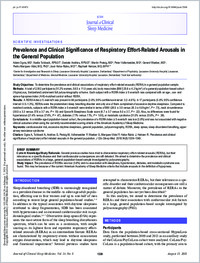Prevalence and Clinical Significance of Respiratory Effort-Related Arousals in the General Population.
- Ogna A Center for Investigation and Research in Sleep, Lausanne University Hospital, Lausanne, Switzerland.
- Tobback N Center for Investigation and Research in Sleep, Lausanne University Hospital, Lausanne, Switzerland.
- Andries D Center for Investigation and Research in Sleep, Lausanne University Hospital, Lausanne, Switzerland.
- Preisig M Department of Psychiatry, Lausanne University Hospital, Lausanne, Switzerland.
- Vollenweider P Department of Medicine, Internal Medicine, Lausanne University Hospital, Lausanne, Switzerland.
- Waeber G Department of Medicine, Internal Medicine, Lausanne University Hospital, Lausanne, Switzerland.
- Marques-Vidal P Department of Medicine, Internal Medicine, Lausanne University Hospital, Lausanne, Switzerland.
- Haba-Rubio J Center for Investigation and Research in Sleep, Lausanne University Hospital, Lausanne, Switzerland.
- Heinzer R Center for Investigation and Research in Sleep, Lausanne University Hospital, Lausanne, Switzerland.
- 2018-08-11
Published in:
- Journal of clinical sleep medicine : JCSM : official publication of the American Academy of Sleep Medicine. - 2018
RERA
cardiovascular risk
excessive daytime sleepiness
general population
polysomnography
sleep apnea
sleep-disordered breathing
upper airway resistance syndrome
Adult
Aged
Arousal
Cohort Studies
Cross-Sectional Studies
Female
Humans
Male
Middle Aged
Monitoring, Ambulatory
Polysomnography
Prevalence
Respiration
Sleep Apnea Syndromes
English
STUDY OBJECTIVES
To determine the prevalence and clinical associations of respiratory effort-related arousals (RERA) in a general population sample.
METHODS
A total of 2,162 participants (51.2% women, 58.5 ± 11.0 years old, body mass index [BMI] 25.6 ± 4.2 kg/m2) of a general population-based cohort (HypnoLaus, Switzerland) underwent full polysomnography at home. Each subject with a RERA index ≥ 5 events/h was compared with an age-, sex- and apnea-hypopnea index (AHI)-matched control without RERA.
RESULTS
A RERA index ≥ 5 events/h was present in 84 participants (3.8%; 95% confidence interval: 3.2-4.8%). In 17 participants (0.8%; 95% confidence interval: 0.5-1.3%), RERAs were the predominant sleep breathing disorder and only one of them complained of excessive daytime sleepiness. Compared to matched controls, subjects with a RERA index ≥ 5 events/h were similar in terms of BMI (26.5 ± 3.5 versus 26.3 ± 4.8 kg/m2, P = .73), neck circumference (38.5 ± 3.3 versus 37.6 ± 3.7 cm, P = .10) and Epworth Sleepiness Scale score (6.7 ± 3.7 versus 6.0 ± 3.7, P = .22). Also, no differences were found for hypertension (21.4% versus 27.4%, P = .47), diabetes (7.1% versus 7.1%, P = 1.00), or metabolic syndrome (31.0% versus 23.8%, P = .39).
CONCLUSIONS
In a middle-aged population-based cohort, the prevalence of a RERA index ≥ 5 events/h was low (3.8%) and was not associated with negative clinical outcomes when using the currently recommended scoring criteria of the American Academy of Sleep Medicine.
To determine the prevalence and clinical associations of respiratory effort-related arousals (RERA) in a general population sample.
METHODS
A total of 2,162 participants (51.2% women, 58.5 ± 11.0 years old, body mass index [BMI] 25.6 ± 4.2 kg/m2) of a general population-based cohort (HypnoLaus, Switzerland) underwent full polysomnography at home. Each subject with a RERA index ≥ 5 events/h was compared with an age-, sex- and apnea-hypopnea index (AHI)-matched control without RERA.
RESULTS
A RERA index ≥ 5 events/h was present in 84 participants (3.8%; 95% confidence interval: 3.2-4.8%). In 17 participants (0.8%; 95% confidence interval: 0.5-1.3%), RERAs were the predominant sleep breathing disorder and only one of them complained of excessive daytime sleepiness. Compared to matched controls, subjects with a RERA index ≥ 5 events/h were similar in terms of BMI (26.5 ± 3.5 versus 26.3 ± 4.8 kg/m2, P = .73), neck circumference (38.5 ± 3.3 versus 37.6 ± 3.7 cm, P = .10) and Epworth Sleepiness Scale score (6.7 ± 3.7 versus 6.0 ± 3.7, P = .22). Also, no differences were found for hypertension (21.4% versus 27.4%, P = .47), diabetes (7.1% versus 7.1%, P = 1.00), or metabolic syndrome (31.0% versus 23.8%, P = .39).
CONCLUSIONS
In a middle-aged population-based cohort, the prevalence of a RERA index ≥ 5 events/h was low (3.8%) and was not associated with negative clinical outcomes when using the currently recommended scoring criteria of the American Academy of Sleep Medicine.
- Language
-
- English
- Open access status
- bronze
- Identifiers
-
- DOI 10.5664/jcsm.7268
- PMID 30092888
- Persistent URL
- https://sonar.ch/global/documents/293777
Statistics
Document views: 15
File downloads:
- fulltext.pdf: 0
